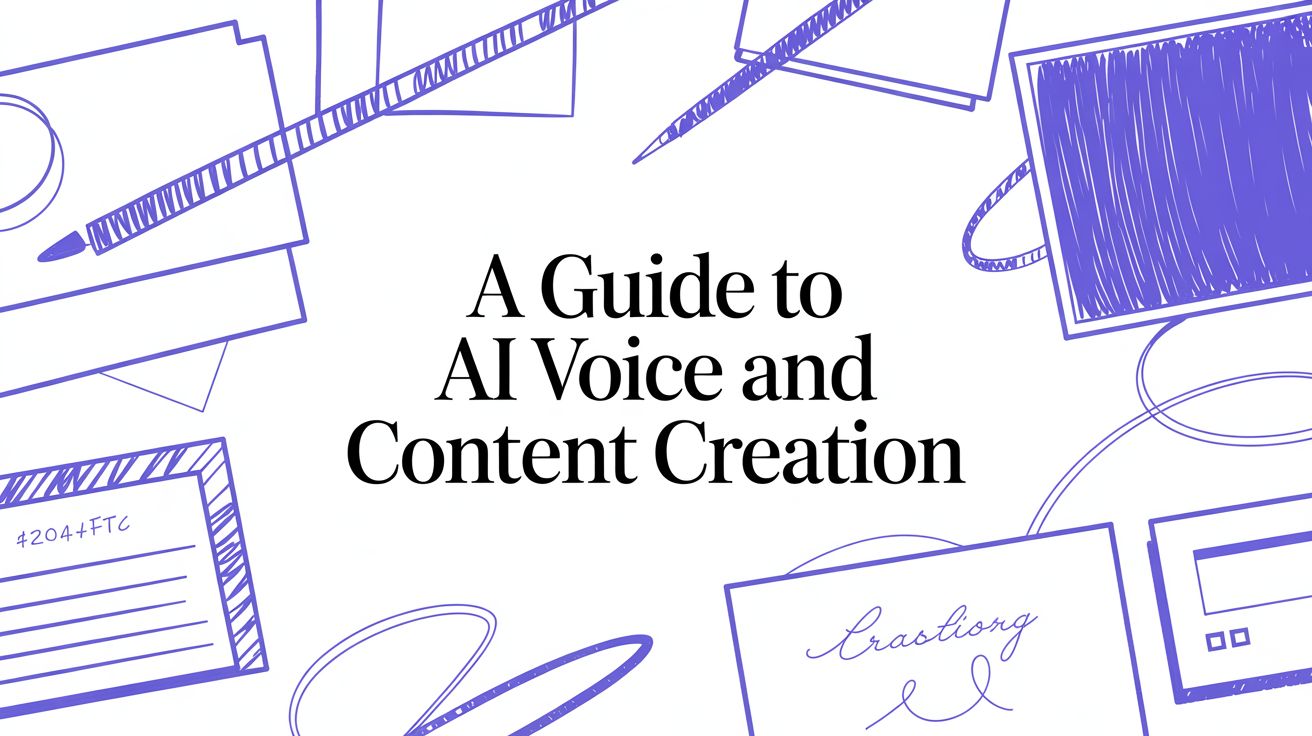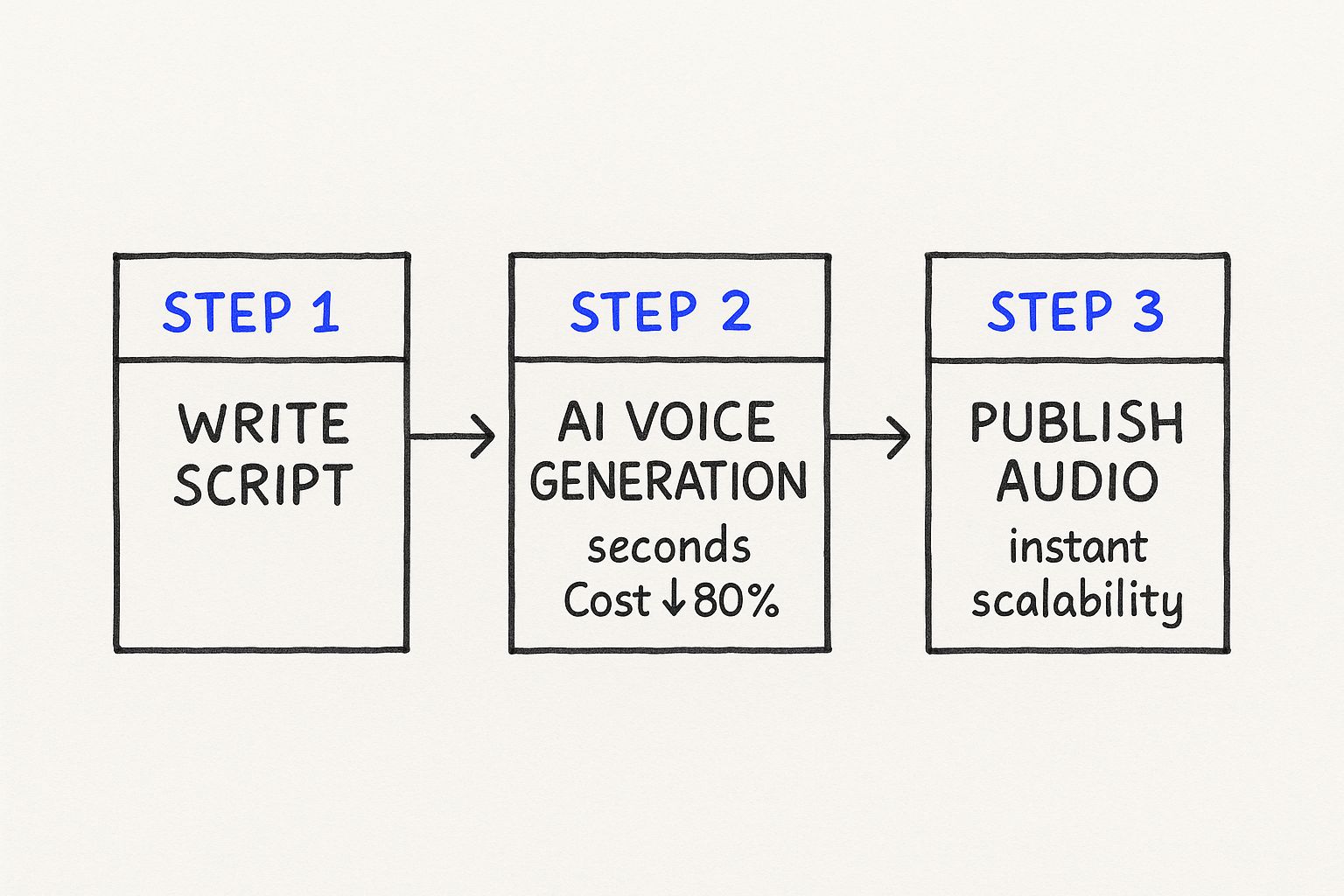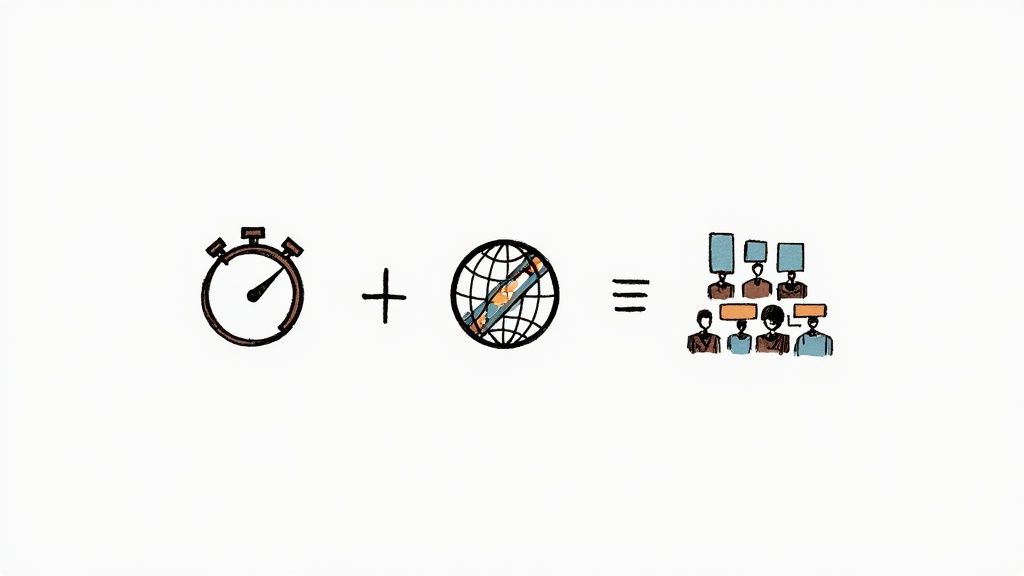A Guide to AI Voice and Content Creation

An AI voice is a synthetic voice brought to life by artificial intelligence, designed to turn any written text into speech that sounds astonishingly human. We're not talking about a simple, robotic playback of words anymore. Today's AI voices can capture the nuances of human tone, pacing, and emotion, making them almost impossible to tell apart from a real person.
What Is AI Voice and Why It Matters Now
If your first thought is of the flat, robotic voices from old sci-fi movies, it's time for an update. AI voice technology has evolved into a powerful tool that’s completely changing how we create and listen to audio content. It's less like a basic text reader and more like a digital voice actor, ready to deliver a perfect performance whenever you need one.
This is a massive shift away from the old way of producing voiceovers, which was often a major headache for creators. The traditional route—hiring voice actors, booking expensive studio time, and managing endless recording sessions—is slow, costly, and doesn't scale well. Even a tiny script change could force you to start the whole process over, tacking on days or even weeks to your project.
The New Era of Audio Production
AI voice completely flips that old model on its head. It opens up the world of audio production to everyone, from solo creators to massive companies, by making studio-quality voiceovers instantly accessible. The benefits are clear right from the start:
- Speed: Forget waiting weeks. You can generate hours of audio in the time it takes to grab a coffee.
- Cost-Effectiveness: Say goodbye to studio rental fees and talent costs. The savings are huge.
- Scalability: Need a voiceover in ten different languages? Or maybe a few different versions for A/B testing? It’s all done in a few clicks, with no need for new recording sessions.
This streamlined workflow, which you can see in the chart below, really drives home just how much more efficient the process becomes. You go straight from script to a published audio file.

As the visual shows, generating audio with AI isn't just a matter of hours—it's seconds. All while cutting costs and giving you the power to scale any project instantly.
Empowering Creators with Unlimited Potential
This is where platforms like Verbatik step in, offering tools like unlimited text to speech and voice cloning. This kind of model gets rid of the creative and financial roadblocks that come with per-character pricing. It frees you up to experiment, make changes, and produce all the content you want without hitting a paywall. For a deeper dive into the core tech, check out our guide on the basics of text to speech and who uses it.
With unlimited access, you stop worrying about word counts and budgets. Your only focus is creating the best audio experience possible for your audience, whether that’s for a podcast, video narration, audiobook, or an online course.
In the end, AI voice is much more than a simple convenience—it’s an essential tool for anyone creating content today. It helps brands build a consistent vocal identity across every platform and lets creators add a professional, engaging audio layer to their work without any friction. Whether you're cloning your own voice for a personal touch or choosing from a library of hundreds of realistic options, professional-grade audio is no longer a luxury. It’s an asset anyone can use to make an impact.
How AI Voice Technology Actually Works

Ever wondered what’s really going on behind the scenes when an AI voice sounds perfectly human? It's not just a computer reading words off a page. The process is a lot more like teaching a musician to perform a complex piece of music.
First, you have to teach the basic notes. For an AI, these "notes" are phonemes—the smallest building blocks of sound in a language. Think of the "c" sound in "cat" or the "sh" in "shoe." The AI meticulously studies massive datasets of human speech to master how every single one of these sounds is formed.
But just knowing the notes doesn't make you a musician. The real magic comes from learning rhythm, tone, and emotion. In speech, this is called prosody—the intonation, stress patterns, and pacing that turn a robotic string of sounds into something that sounds genuinely human and engaging.
From Robotic Sounds to Neural Networks
Getting to today’s incredibly realistic AI voices was a long road. The first text-to-speech (TTS) systems relied on a method called concatenative synthesis. Essentially, they chopped up pre-recorded human speech into tiny pieces and then stitched them back together to form new sentences. It worked, but you could often hear the seams, resulting in that choppy, robotic voice we all remember.
The game changed completely with the arrival of neural networks and deep learning. Instead of just gluing old sounds together, modern AI voice generators use these powerful models to create speech entirely from scratch, generating the audio waveform bit by bit. This gives them the ability to produce incredibly smooth and natural-sounding audio.
This new approach allows the AI to finally grasp context. It learns that the word "read" sounds different in "I will read the book" versus "I have read the book"—a tiny detail that makes all the difference in sounding human.
This is why today's AI voices can handle tricky sentences, express nuanced emotions, and sound far more convincing than their predecessors. To dive deeper into how this tech evolved, check out our guide on text to speech technology.
The Power of Voice Cloning Explained
Taking this neural network foundation a step further, we get to the incredible world of voice cloning. This is where an AI can create a digital copy of a specific person's voice using just a short audio sample. It’s the key to creating a unique and consistent vocal identity for your brand or project.
Here’s the actionable breakdown of how it works:
- Analysis: The AI listens to a sample of a voice and breaks it down into its unique characteristics—pitch, tone, accent, and subtle speech habits.
- Model Creation: It uses this analysis to build a digital blueprint of that specific voice. This becomes its unique vocal model.
- Synthesis: Once the model is ready, the AI can generate brand-new speech from any text you give it, all in that perfectly replicated voice.
This opens up a ton of creative possibilities. Imagine a podcaster fixing a mistake without having to re-record an entire segment, or a business creating a single, recognizable voice for all of its marketing and training content.
Platforms like Verbatik put this power in your hands by offering unlimited voice cloning. You’re not capped on how many times you can use your cloned voice, giving you total freedom to produce consistent, professional-grade audio for any project. You can just focus on creating great content, knowing your voice will always be on-brand.
Unlock Your Workflow with AI Voice

It’s one thing to understand the tech, but it’s another thing entirely to see how an AI voice can completely change your day-to-day work. This isn't just a minor upgrade; it's a total reimagining of the audio production process, built on three game-changing pillars: efficiency, scalability, and consistency.
These aren't just buzzwords. They represent a fundamental shift that moves AI voice from a "nice-to-have" novelty to an indispensable tool for any modern creator or business. It tackles the biggest headaches that have held back audio content for years.
Achieve Radical Efficiency and Cost Savings
Anyone who’s produced voiceovers knows the old way is painful. It’s a slow, expensive dance of coordinating with voice actors, booking pricey studio time, and slogging through post-production edits. Even a tiny script change can send you back to square one, torching your timeline and budget.
AI voice generation blows that old model up.
Instead of waiting days or weeks for a recording, you can generate crystal-clear audio in minutes. That speed has a direct impact on your wallet, as you can erase line items for talent fees, studio rentals, and sound engineers.
With AI, a production timeline that once took weeks is crushed down to minutes. The budget required for professional audio drops just as dramatically. This isn't just about saving money; it's about reallocating those resources to what really matters, like marketing and distribution.
This newfound speed lets you move faster and be more responsive. Need a voiceover for a TikTok video, a quick training update, or a new ad campaign? You can generate it almost instantly, keeping your content fresh without draining your bank account.
To see the difference in black and white, let's compare the old way with the new.
Traditional Voiceover vs AI Voice Generation
| Feature | Traditional Voiceover | AI Voice (e.g., Verbatik) |
|---|---|---|
| Turnaround Time | Days to weeks | Minutes |
| Cost | High (actors, studio, engineers) | Low, predictable subscription |
| Revisions | Costly and time-consuming | Instant and free |
| Scalability | Difficult and expensive | Effortless, unlimited versions |
| Language Options | Limited by actor availability | Hundreds of languages instantly |
| Consistency | Varies between actors/sessions | 100% consistent with a chosen voice |
The table makes it pretty clear. For creators who need to move quickly and efficiently, the advantages of AI voice are undeniable.
Unlock Infinite Scalability for Global Reach
One of the biggest wins with AI voice is its incredible ability to scale. Let’s say you need to launch a new marketing campaign in five different countries at the same time. The old way would mean hiring five different voice actors and managing five separate projects. It's a logistical nightmare.
An AI voice platform turns this into a non-issue.
You can take one script and instantly generate it in multiple languages or with different regional accents. This ensures your message lands perfectly with local audiences, no matter where they are. For brands looking to go global, this is a massive advantage.
But scalability isn't just about language. You can create dozens of variations of a single ad script for A/B testing or customize training videos for different teams within your company. For developers, integrating Verbatik's TTS API into your workflow opens the door to automating this kind of large-scale audio production.
Maintain Perfect Brand Consistency
A consistent brand voice builds trust and makes you memorable. But keeping that voice the same across all your content over months or years is tough, especially when you’re relying on different voice actors who might have their own style or become unavailable.
Voice cloning is the perfect answer to this problem.
By creating a digital copy of a specific voice, you can establish a single, signature audio identity for your brand. This means every piece of audio you produce—from your podcast intro to your YouTube narration—sounds exactly the same. It reinforces your brand identity at every single touchpoint.
This is where a service like Verbatik, which offers unlimited text to speech and unlimited voice cloning, becomes a secret weapon. It removes the barriers to creating consistent, high-quality audio, so you can use your brand's unique voice as often as you need without ever worrying about extra costs.
Once you have a consistent voice ready to go, the next step is putting it to work. If you're a creator, you can discover actionable TikTok content ideas that are perfect for a recognizable AI voice that will make your content stand out.
Putting AI Voice to Work in Your Industry

It’s one thing to talk about the potential of AI voice, but it’s another thing entirely to see what it can do in the real world. This isn't just about futuristic concepts; it's about solving real problems, sparking creativity, and getting tangible results right now. So, let's look at how creators, businesses, and educators are already getting a huge advantage from AI voice.
And this isn't just a tool for massive companies with deep pockets. Platforms offering unlimited text to speech, like Verbatik, have made this technology accessible to everyone, from a one-person startup to a global corporation. The objective is always the same: create incredible audio, faster and without breaking the bank.
Fueling the Creator Economy
If you’re a creator on YouTube or Spotify, you know the grind. The demand for fresh, engaging content is relentless. A professional-sounding narration can make or break a project, but hiring voice talent for every single piece of content creates a huge bottleneck.
An AI voice generator smashes that friction. A YouTuber can knock out a script for a documentary and generate a perfect, human-like voiceover in just a few minutes. If a podcaster flubs a line, they can fix it instantly without having to re-record the whole take. That kind of speed and control is a total game-changer.
Actionable Insight: Use an AI platform with unlimited voice cloning to create a digital copy of your own voice. This allows you to produce professional narration for your weekly video series whenever you need it, maintaining a personal connection with your audience while slashing production time and costs.
This is exactly why the market is exploding. Projections show the global AI voice generators market rocketing from USD 6.40 billion in 2025 to an astonishing USD 54.54 billion by 2033. That growth is all thanks to the technology's ability to create audio that's virtually indistinguishable from a human pro. You can dig into the numbers yourself by reading the full research on the AI voice market.
Transforming Corporate Training and Accessibility
In the corporate world, clear communication is everything. Companies are always creating training materials, marketing videos, and internal updates, and all of them are better with a professional voice.
Imagine a global firm that needs to push out new compliance training to teams across different countries. Instead of the nightmare of recording the module in a dozen languages—a slow and expensive headache—they can use AI to generate localized audio instantly. This guarantees every single employee gets the same quality of training in their native language.
On top of that, AI voice is a massive win for accessibility.
- For Visually Impaired Audiences: Businesses can turn written reports, articles, and entire websites into audio, opening up their content to everyone.
- For E-Learning: A good AI voice can turn dry, dense training material into something much easier to listen to and remember, boosting how much people actually learn.
By making information audible, companies aren't just ticking a compliance box. They're connecting with people based on how they prefer to learn, which makes their entire communication strategy stronger. To get more ideas, check out our article on leveraging text to speech for business growth.
Innovating in Education and Publishing
Education is another field being completely reshaped by AI voice. Teachers and course designers can build interactive e-learning modules where students can listen to lessons, which is a huge help for auditory learners or anyone who wants a break from the screen.
The publishing world is also seeing a massive shift. Authors can now turn their books into high-quality audiobooks without the eye-watering cost of hiring a narrator and booking a studio for weeks. This blows the doors open to the audiobook market for independent authors and smaller publishers who were always priced out. With Verbatik's unlimited text to speech model, an author can produce an entire audiobook for one flat cost, tapping into a whole new audience and revenue stream.
How to Choose the Right AI Voice Generator
With the market for AI voice tools getting more crowded, picking the right one can feel like a shot in the dark. To nail the choice, you need a clear idea of what actually matters for your projects. The best generator isn't just about a realistic voice; it’s about finding a platform that slots perfectly into your workflow, goals, and budget.
First things first: the quality and realism of the voices are non-negotiable. Listen to the samples. I mean, really listen. Do they sound natural and engaging, or can you still hear that tell-tale robotic flatness? A great AI voice nails the little things—the subtle shifts in pitch, pacing, and emotion that make human speech compelling.
Look Beyond Just Voice Quality
While a realistic voice is your starting point, a deep and diverse library is just as crucial. The right tool should give you a wide selection of voices covering different genders, ages, and accents. This variety is what lets you find the perfect match for any project, from a straight-laced corporate training video to an expressive narrative podcast.
Don't forget about language support either. If you're creating content for a global audience, find a generator that offers voices in multiple languages and even regional dialects. This is a massive advantage, letting you scale your content internationally without the logistical nightmare of sourcing local voice actors for every market.
Actionable Tip: Don't just pick a realistic voice; pick a platform that gives you precise control. Look for features that let you fine-tune speed, pitch, and emotional tone to match your exact vision, turning a good voiceover into a great one.
Fine-tuning capabilities are what separate the good tools from the great ones. Look for features that let you adjust variables like speed, pitch, and emotional tone. Being able to add pauses for dramatic effect, emphasize specific words, and control the overall delivery gives you the director's chair for your audio. For a deeper dive into what a top-tier platform offers, check out our complete guide on finding the best AI voice generator for you.
Comparing Pricing Models: The Unlimited Advantage
Finally, you have to look closely at the pricing model. This is what will have the biggest long-term impact on your creative freedom and budget. Many services run on a restrictive per-character or per-word basis. This might look cheap for a tiny, one-off project, but the costs add up incredibly fast for anyone with regular audio needs.
This pay-as-you-go approach creates friction. It forces you to constantly count characters and second-guess every script revision because of the budget. It actively discourages experimentation and makes producing content at scale a real headache.
On the other hand, a subscription-based model gives you far more value and predictability. For instance, Verbatik offers unlimited text to speech and voice cloning, which completely changes the equation. This model sets you free to generate as much audio as you need for one flat fee. You can try out different voices, tweak scripts to your heart's content, and produce hours of content without ever worrying about a paywall. For creators, marketers, and businesses, this unlimited model is a clear winner, offering predictable costs and the creative freedom you need to produce great audio, consistently.
The Future of AI Voice and Human Interaction
Looking ahead, AI voice is shaping up to be much more than just a tool for creating content. It's quickly becoming a fundamental part of how we engage with our digital lives, branching out from our screens into our smart devices, cars, and even virtual worlds. This shift points to voice as the next major user interface—a far more natural and conversational way to get things done with technology.
The next big leap is emotionally intelligent AI that can pick up on a user's tone and react accordingly. Picture a customer service bot that actually senses your frustration and responds with real empathy, or a virtual assistant that changes its communication style to match your mood. This isn't science fiction; it’s the next step in making our interactions with machines feel less robotic and more genuinely helpful.
The Rise of Voice as an Interface
As tech gets more woven into our daily routines, the need for seamless interaction is growing. It's just faster and more intuitive to speak than to type, which is why voice commands are now becoming the norm in everything from smart homes to in-car navigation. This isn't just about making things easier; it’s about creating a digital experience that feels more human.
The key takeaway is that AI voice is a foundational technology poised to reshape customer service, accessibility, and our daily digital routines. It promises a future where interacting with complex systems is as simple as having a conversation.
This shift isn't just a hunch; the numbers back it up. The market for Voice AI agents is projected to skyrocket to USD 47.5 billion by 2034, a massive jump from USD 2.4 billion in 2024. With 89% of consumers saying they prefer brands that offer Voice AI support, it's clear this is a fundamental change in what people expect.
Navigating the Ethical Landscape
Of course, with great power comes great responsibility. These advancements bring some important ethical questions to the table, especially around the responsible use of voice cloning. As this technology becomes easier for everyone to access, getting consent and preventing misuse are non-negotiable.
Platforms like Verbatik, which offers unlimited voice cloning, are built with these responsibilities in mind. The goal is to use this powerful tool to boost creativity and keep brand messaging consistent, never to deceive.
As AI voice continues to evolve, understanding how people use it is essential. You can learn practical ways to get your content noticed by voice assistants if you optimize for voice search. The future belongs to the creators and companies who embrace this technology thoughtfully, using its incredible potential to build better, more natural digital experiences for all of us.
Common Questions About AI Voice
As you start digging into AI voice technology, you're bound to have some questions. It’s a fast-moving space, after all. To give you some solid, actionable answers, we've rounded up a few of the most common things people ask once they get past the basics.
How Realistic Can an AI Voice Actually Sound?
Honestly, it's pretty mind-blowing. The best AI voices today are so realistic that they're often completely indistinguishable from a human speaker. We're not talking about that old robotic GPS voice anymore.
Modern platforms use sophisticated neural networks that have been trained on thousands of hours of human speech. This allows them to pick up on all the subtle stuff—emotion, pacing, and intonation—that makes a voice sound alive. While quality definitely varies, the top-tier services produce crystal-clear, natural audio that's perfect for professional work like audiobooks, ads, and video narration.
Is Using an AI Voice Generator Difficult?
Not in the slightest. The leading tools are built to be incredibly straightforward. Forget needing an audio engineering degree; the whole process is usually just a few clicks.
You simply paste your text into an editor, pick a voice you like from a library, and hit "generate." Most platforms also give you easy-to-use sliders and menus to fine-tune things like speed, pitch, or even the emotional tone, so you can get the delivery just right without any technical headaches.
The whole point of a great AI voice platform is to get the tech out of your way. It’s designed to let you focus on your message and your creativity, not a complicated user manual.
What Is AI Voice Cloning and How Does It Work?
AI voice cloning is exactly what it sounds like: creating a perfect digital copy of a specific person's voice. All it takes is a short audio sample. The AI analyzes everything that makes that voice unique—the tone, the accent, the rhythm—and builds a model that can speak any text you give it.
This is a huge deal for creators and brands who want to maintain a consistent sound. For instance, platforms like Verbatik offer unlimited voice cloning, which means you can use your own unique voice for every single project without having to record new audio each time. It ensures every piece of content sounds exactly on-brand, every time.
Can I Use AI-Generated Voices for Commercial Projects?
Absolutely. When you sign up for a paid plan with a reputable AI voice platform, you're almost always granted full commercial rights to the audio you create. That means you're clear to use it for monetized YouTube channels, advertisements, online courses, or any other business project.
That said, it’s always smart to take a quick look at the terms of service for whatever tool you choose. This just makes sure you're fully aligned with their licensing rules before you go live with your content.
Ready to bring your projects to life with a stunningly realistic AI voice? Verbatik offers unlimited text-to-speech, instant voice cloning, and a full suite of AI content creation tools to help you produce studio-quality audio in seconds. Start creating for free today at Verbatik.
